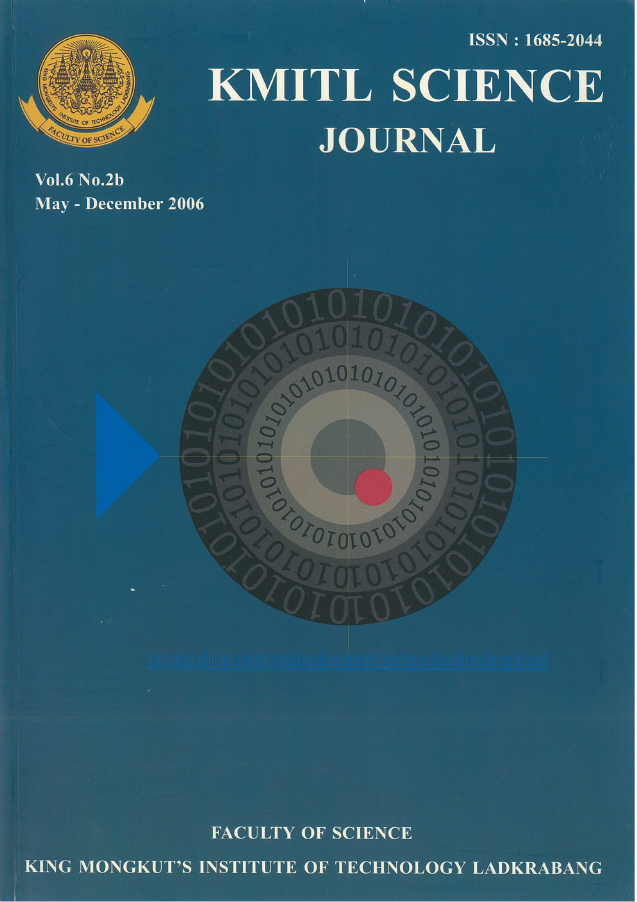Volatile Compounds of Fresh Flowers
Main Article Content
Abstract
HS-SPME/GC-MS was used for qualitative analysis of volatile compounds emitted from four types of fresh flowers: Dok Kaew, Dok Mok, Dok Phakakrong and Dok Tanyong. Volatile compounds in headspace were absorbed on PDMS/DVB fiber at room temperature for 15 minutes, the adsorbed compounds were thermally desorbed at 200°C in an injection port of GC and analysis by GC-MS. The results showed that the emitted volatile compounds in headspace have the differences in the profiles of compounds depend on type and the time after the flowers were picked. Total 75 compounds were detected and the important groups of compound were alkene, ester, aldehyde, ketone and alcohol with various quantity. The 53, 20, 35 and 2 compounds were found in headspace of Dok Kaew, Dok Mok, Dok Phakakrong and Dok Tanyong, respectively. The main compounds of Dok Kaew were benzaldehyde (53.6%), benzene acetaldehyde (13.0%) and β-cubebene (10.3%); in Dok Mok were benzaldehyde (28.6%) and benzene acetaldehyde (28.2%) in Dok Phakakrong were trans-β-ocimene (35.0%) and trans-caryophyllene (10.7%). High level of p-methylanisole (98.90%) was found in Dok Tanyong.
Keywords: Headspace Solid Phase Microextraction, Gas Chromatography-Mass Spectrometry flower, Dok Kaew, Dok Mok, Dok Phakakong and Dok Tanyong
Corresponding author: E-mail: winyu.chi@kmutt.ac.th
Article Details
Copyright Transfer Statement
The copyright of this article is transferred to Current Applied Science and Technology journal with effect if and when the article is accepted for publication. The copyright transfer covers the exclusive right to reproduce and distribute the article, including reprints, translations, photographic reproductions, electronic form (offline, online) or any other reproductions of similar nature.
The author warrants that this contribution is original and that he/she has full power to make this grant. The author signs for and accepts responsibility for releasing this material on behalf of any and all co-authors.
Here is the link for download: Copyright transfer form.pdf
References
[2] www.http://www.sisweb.com/reference/applnote/app-55.html
[3] Deng C, Song G, and Hu Y 2004 Application of HS-SPME and GC-MS to characterization of volatile compounds emitted from Osmanthus flowers. Ann Chim 94(12) 921-927
[4] Liu BZ. and Gao Y. 2004 Analysis of headspace constituents of Gardenia flower by GC/MS with solid-phase microextraction and dynamic headspace sampling. Chinese journal of chromatography 18(5):452-5
[5] Seung-Joo, L., Katumi, U., Takayuki, S. and Kwang-Geun, L. 2005 Aroma compounds in the extracts of basil leaves (Ocimum basilicum L.) and thyme leaves (Thymus vulgaris L.) and their antioxidant properties. Food Chemistry, 91, 131-137.
[6] Guy, A., Félicien, A., Innocent, B., Edwige, A., Justine, D. and Dominique C.K. Sohounhloué 2004 Composition chimique et activities biologiques de l’huile essentielle de Lantana camara Linn. Comptes Rendus Chimie. 7(10-11), 1101-1105.
[7] Ruy, J.V. Alvesa, Angelo, C. Pintob, Alexandre V. M. da Costab and Claudia, M. Rezende. 2005 Zizyphus mauritiana Lam. (Rhamnaceae) and the chemical composition of its floral fecal Odor. J. Braz. Chem. Soc. 16(3B), 654-656.
[8] Chang, S.T. and Cheng, S.S. 2002 Antitermitic activity of leaf essential oils and components from Cinnamomum osmophleum. J. Agric. Food Chem, 50, 1389-1392.


